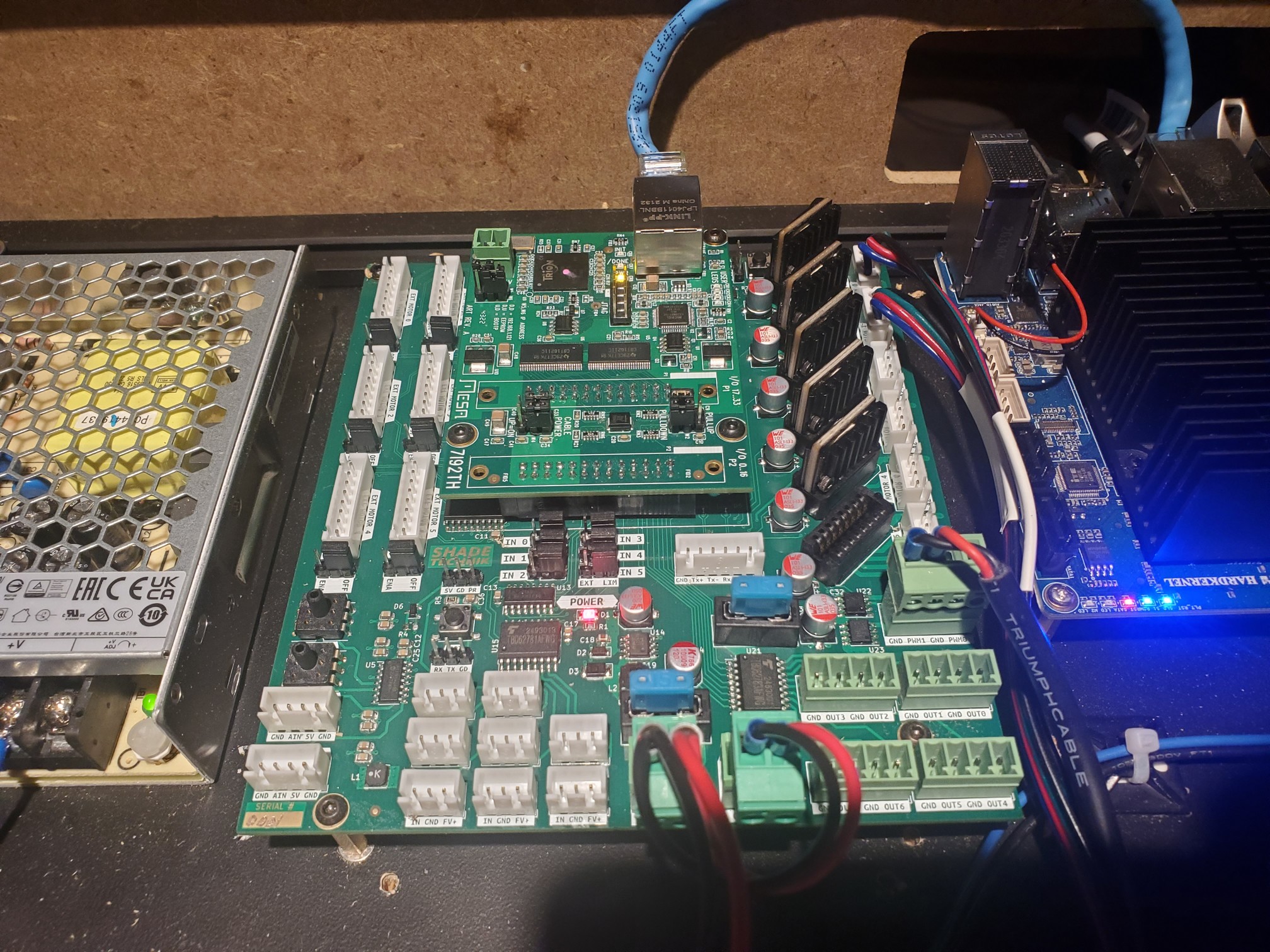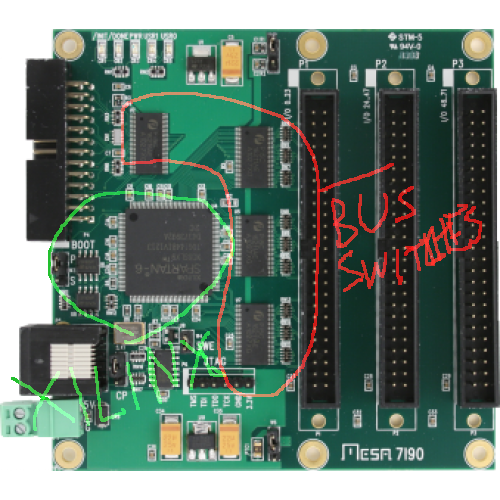about Mesa bus switches
- Gene1934
- Offline
- Elite Member
-

Less
More
- Posts: 174
- Thank you received: 13
18 Nov 2023 19:07 #285849
by Gene1934
Cheers, Gene Heskett
--
"There are four boxes to be used in defense of liberty:
soap, ballot, jury, and ammo. Please use in that order."
-Ed Howdershelt (Author)
Genes Web page <geneslinuxbox.net:6309/gene>
about Mesa bus switches was created by Gene1934
I should clarify what interface I am currently using with the rp4b, and the reason I mentioned rpspi.ko as the driver.
It is an inexpensive mesa 7i90HD which has a huge achilles heel in that it has no buffering between the fpga and the outputs which are also on hard to use 50pin dual row sockets identical to the old cables used with scsi-2 drives.
Mesa also has/had a 7i42TA card which you can stair case mount on top of the 7i90HD which brings the 50 pinners out to a more std 2 row screw header similar to the connectors used on our popular drivers, and which make hooking it all up a piece of cake, and it does a great job of gobbling up the noise that can kill an fpga in microseconds, but it also brings the price for all of this to around $200 USD.
Its an extremely capable interface, giving 72 total pins I'm only using around half of.
Room for tool changers, tool post grinders, smart tailstock controls etc. If you can program it into hal, this interface combo can do it.
And more importantly my ethernet port is free to be used for std networking, I can browse this ball of rock and water with firefox and the only problem is firefox's hogging of IRQ's plays hell with the latency, so I don't run gcode while checking you-tube.
That also leaves its usb ports free, so I have two SSD's on them that allow me to run both a kernel build and a build of master from github, right on that rpi4b as I've a buildbot I wrote there.
It is an inexpensive mesa 7i90HD which has a huge achilles heel in that it has no buffering between the fpga and the outputs which are also on hard to use 50pin dual row sockets identical to the old cables used with scsi-2 drives.
Mesa also has/had a 7i42TA card which you can stair case mount on top of the 7i90HD which brings the 50 pinners out to a more std 2 row screw header similar to the connectors used on our popular drivers, and which make hooking it all up a piece of cake, and it does a great job of gobbling up the noise that can kill an fpga in microseconds, but it also brings the price for all of this to around $200 USD.
Its an extremely capable interface, giving 72 total pins I'm only using around half of.
Room for tool changers, tool post grinders, smart tailstock controls etc. If you can program it into hal, this interface combo can do it.
And more importantly my ethernet port is free to be used for std networking, I can browse this ball of rock and water with firefox and the only problem is firefox's hogging of IRQ's plays hell with the latency, so I don't run gcode while checking you-tube.
That also leaves its usb ports free, so I have two SSD's on them that allow me to run both a kernel build and a build of master from github, right on that rpi4b as I've a buildbot I wrote there.
Cheers, Gene Heskett
--
"There are four boxes to be used in defense of liberty:
soap, ballot, jury, and ammo. Please use in that order."
-Ed Howdershelt (Author)
Genes Web page <geneslinuxbox.net:6309/gene>
Please Log in or Create an account to join the conversation.
- blazini36
- Offline
- Platinum Member
-

Less
More
- Posts: 972
- Thank you received: 167
19 Nov 2023 20:16 #285949
by blazini36
That's more or less the point. These types of cards also us bus switches between the FPGA and the pin headers. It's not the "Field IO" some of the cards have but it does decouple the FPGA from external devices.
Replied by blazini36 on topic about Mesa bus switches
That's not an "achilles heel" and it's actually not quite true. All of the 26/50 pin headers on Mesa cards are like "GPIO" on any other device, 5v tolerant and not "field ready". That's the point of the card, you add the field level IO and firmware as necessary rather than having a card that you're locked into. I use a 7i92 to make this:It is an inexpensive mesa 7i90HD which has a huge achilles heel in that it has no buffering between the fpga and the outputs which are also on hard to use 50pin dual row sockets identical to the old cables used with scsi-2 drives.
That's more or less the point. These types of cards also us bus switches between the FPGA and the pin headers. It's not the "Field IO" some of the cards have but it does decouple the FPGA from external devices.
Attachments:
Please Log in or Create an account to join the conversation.
- Gene1934
- Offline
- Elite Member
-

Less
More
- Posts: 174
- Thank you received: 13
19 Nov 2023 21:10 #285957
by Gene1934
Cheers, Gene Heskett
--
"There are four boxes to be used in defense of liberty:
soap, ballot, jury, and ammo. Please use in that order."
-Ed Howdershelt (Author)
Genes Web page <geneslinuxbox.net:6309/gene>
Replied by Gene1934 on topic about Mesa bus switches
Ahh, but unless Peter has modified the 7i90HD, there is none of that on /that/ card, the 50 pinners are connected directtly to the FPGA, and can be easily destroyed by voltages even 1 vbe above the 3.3 volts from circuit noise or ringing, and from Peter, even less than a vbe below ground.
I destroyed three of them, and the 4th has one blown gpio before I bought and installed the 7i42TA's which protect the fpga. That's one of the reasons that card was so low priced at $65 USD when I was trying to prove I could run cnc on an rpi3b originally. Then I also redid the grounding into a single bolt star ground, which killed 98% of the noise.
I am a CET, and own Siglents priciest scope, a 4 channel sampler with a 350 MHZ front end, and its amazing what you can see and analyze with that in your hand. The ringing of a circuit edge going up can be seen with the ring above 3.3 volts being squared off, clipped at 3.4 volts by the action of that 7i42TA. Ditto the corresponding spike at the falling edge, clipped flat for several nanoseconds at about -.15 volts. The 7i42TA is doing its job.
Those buffers are on the 7i92, but not on the 7i90HD,
As for the rpi3b, just barely, but the rpi4b does it easily even though I have stuff in the hal file and pyvcp that most haven't thought of yet. But while the hal file is huge for a lathe, the rpi4b running my kernel does well with time to spare.
My kernel is a 4.19 rt derivative I built right on the pi. latency is about 12 microseconds. On the bookworm-rt kernel its around 50 microseconds but it still runs that elderly Sheldon 11x54 as if Casper the ghost was turning the cranks even at speeds you can't turn them.
I destroyed three of them, and the 4th has one blown gpio before I bought and installed the 7i42TA's which protect the fpga. That's one of the reasons that card was so low priced at $65 USD when I was trying to prove I could run cnc on an rpi3b originally. Then I also redid the grounding into a single bolt star ground, which killed 98% of the noise.
I am a CET, and own Siglents priciest scope, a 4 channel sampler with a 350 MHZ front end, and its amazing what you can see and analyze with that in your hand. The ringing of a circuit edge going up can be seen with the ring above 3.3 volts being squared off, clipped at 3.4 volts by the action of that 7i42TA. Ditto the corresponding spike at the falling edge, clipped flat for several nanoseconds at about -.15 volts. The 7i42TA is doing its job.
Those buffers are on the 7i92, but not on the 7i90HD,
As for the rpi3b, just barely, but the rpi4b does it easily even though I have stuff in the hal file and pyvcp that most haven't thought of yet. But while the hal file is huge for a lathe, the rpi4b running my kernel does well with time to spare.
My kernel is a 4.19 rt derivative I built right on the pi. latency is about 12 microseconds. On the bookworm-rt kernel its around 50 microseconds but it still runs that elderly Sheldon 11x54 as if Casper the ghost was turning the cranks even at speeds you can't turn them.
Cheers, Gene Heskett
--
"There are four boxes to be used in defense of liberty:
soap, ballot, jury, and ammo. Please use in that order."
-Ed Howdershelt (Author)
Genes Web page <geneslinuxbox.net:6309/gene>
Please Log in or Create an account to join the conversation.
- Cant do this anymore bye all
-

- Offline
- Platinum Member
-

Less
More
- Posts: 1200
- Thank you received: 425
20 Nov 2023 07:55 #285998
by Cant do this anymore bye all
Replied by Cant do this anymore bye all on topic about Mesa bus switches
Pete's comment here is interesting regarding the 7i90HD output chips
forum.linuxcnc.org/27-driver-boards/3639...d-as-a-7i90hd#131165
I'm using 74cbt3245's on my cobbled together 7i90HD clone.
forum.linuxcnc.org/27-driver-boards/3639...d-as-a-7i90hd#131165
I'm using 74cbt3245's on my cobbled together 7i90HD clone.
Please Log in or Create an account to join the conversation.
- blazini36
- Offline
- Platinum Member
-

Less
More
- Posts: 972
- Thank you received: 167
20 Nov 2023 16:28 - 20 Nov 2023 16:31 #286059
by blazini36
Replied by blazini36 on topic about Mesa bus switches
You're are getting confused. Page 2 of the 7i90HD manual:
All that talk about electronics gizmos and you can't see the bus switches on the card? Even in the pictures? I own a 3 $200 Chinese scopes and even I can see the bus switches.
I doubt Mesa has any card where the IO goes straight to the FPGA
You can see the bus switch ICs on the picture of the 7i90HD, there's like 4 of them, They are probably SN74CBT16211CDGGR, which is the same as on the 7i92. I've had to replace them already (my fault).To allow interfacing with 5V inputs, the 7I90HD has bus switches on all I/O
pins. The bus switches work by turning off when the input voltage exceeds a preset
threshold. The 5V I/O tolerance option is the default and should normally be left enabled
All that talk about electronics gizmos and you can't see the bus switches on the card? Even in the pictures? I own a 3 $200 Chinese scopes and even I can see the bus switches.
I doubt Mesa has any card where the IO goes straight to the FPGA
Last edit: 20 Nov 2023 16:31 by blazini36.
The following user(s) said Thank You: Cant do this anymore bye all
Please Log in or Create an account to join the conversation.
- Gene1934
- Offline
- Elite Member
-

Less
More
- Posts: 174
- Thank you received: 13
20 Nov 2023 17:30 #286066
by Gene1934
Cheers, Gene Heskett
--
"There are four boxes to be used in defense of liberty:
soap, ballot, jury, and ammo. Please use in that order."
-Ed Howdershelt (Author)
Genes Web page <geneslinuxbox.net:6309/gene>
Replied by Gene1934 on topic about Mesa bus switches
Well, I went to the garage and tried to find one of the blown ones but failed and I'm not about to rip my rig apart cuz its on the bottom of 3 stack of 7i42TA's. My doc booklets I saved in the lathes drawer do not contain drawings that confirm or deny the presence of the switches, All I know is that I blew them up nearly instantly on the first motor movement. My grounding wasn't single bolt star. Bad dog, no bisquit. My best scope at the time was a 100 Mhz dual trace crt hitachi that is still usable at a180 mhz yet today, but has been supplanted with Siglents best 4 channel storage with a 350 MHz front end. Sweet but at $3400 a little pricy for a hobbiest, Ditto their similarly priced vna., draws realtime smith charts as I'm a CET and a more or less retired broadcast engineer. Whatever, its working now and that is what counts.
Cheers, Gene Heskett
--
"There are four boxes to be used in defense of liberty:
soap, ballot, jury, and ammo. Please use in that order."
-Ed Howdershelt (Author)
Genes Web page <geneslinuxbox.net:6309/gene>
Please Log in or Create an account to join the conversation.
- blazini36
- Offline
- Platinum Member
-

Less
More
- Posts: 972
- Thank you received: 167
20 Nov 2023 18:11 #286073
by blazini36
Replied by blazini36 on topic about Mesa bus switches
No, what counts is when you post things on forums that are a "matter of fact" you should at least try to be correct. I've been wrong many times but when it's obvious I'm wrong I admit it. The 7i90HD never got a Trion FPGA revision so there's probably only ever been 1 major revision and judging by the picture it has the same exact bus switch layout every Mesa card with a pin header or DB25 has:
Attachments:
The following user(s) said Thank You: Cant do this anymore bye all
Please Log in or Create an account to join the conversation.
Time to create page: 0.173 seconds


